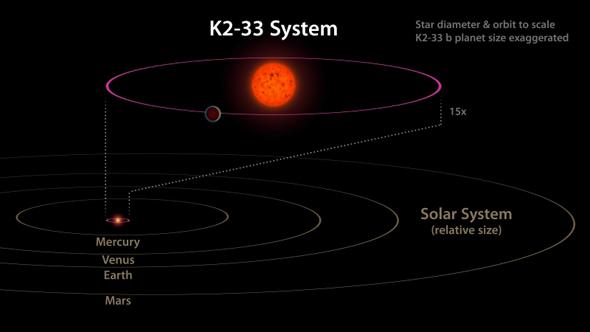Two new exoplanets have been discovered, and they’re important milestones in our understanding of how alien solar systems behave. That’s because both are very young, both are massive, and both orbit their stars very close in, closer than Mercury orbits the Sun.
First, a quick intro to the problem: When astronomers first started finding planets around other stars in the mid-1990s, they were surprised to find that many were as big and massive as Jupiter but so close to their parent stars that they had orbital periods measured in days. Given that Mercury, the innermost planet in our solar system, is small and takes three months to circle the Sun, these “hot Jupiters” were pretty shocking. How did they get there?
Models of planetary formation show that it’s very unlikely a big planet can form so close to the star. Most likely, they form farther out and somehow migrate in toward the star. One way would be to interact with the disc of debris circling the star from which the planet formed. As it plows into this material, it can drop down to the star. It’s unclear if this happens very early in the life of the planet (like, within a million years or so after it forms) or much later, like right before the debris disk is blown away by the star millions of years later.
Another way would be for it to gravitationally interact with other planets in the system, which can affect their orbits. This method takes a while, though, and is slower in general than the debris disk method. The problem: Most planets found are old, a billion years or more, so it’s hard to know just when the hot Jupiter moved.
These two new planets change that.
One is called K2-33b and was found by the Kepler spacecraft, the one that has discovered so many alien worlds. The star, K2-33, is about 460 light-years away and is a cool red dwarf, only about 0.6 times the mass of the Sun and shining at a feeble 15 percent as bright*. It’s part of a loose cluster of stars called the Scorpius-Centaurus OB Association, which is known to be young. The colors of the star also indicate youth (it’s still very hot from its formation, so it’s bluer than you’d expect), and the smoking gun is the presence of lithium in the star’s atmosphere; that element gets destroyed by a star very quickly, so seeing any at all means the star is very young. All together, this points to an age of no more than 20 million years, and most likely closer to 11 million years.
Our own Sun is 4.56 billion years old, so this star is basically a wee bairn.
K2-33b, the planet (note the “b”) is roughly 60,000 kilometers across, a bit less than five times Earth’s diameter. It has no more than the mass of Jupiter, and likely has less—it’s more like a super-Neptune or a mini-Jupiter. It orbits the star every 5.4 days, so it’s close.
Given its youth, that strongly indicates that massive planets can migrate rapidly toward their star right after they’re born, perhaps even while they’re still forming.

NASA/JPL-Caltech
But wait! There’s more! We have the other planet, too.
Before I even get started, let me say that this second planet has not yet been confirmed, but given the circumstances it seems very likely it’s real. I’d be happier with more independent evidence, but the authors indicate the probability of it actually existing is very high.
This one orbits the star V830 Tau, which has a mass almost the same as the Sun, but is twice the radius and about 20 percent more luminous. The planet orbits the star every five days at a distance of just 8.5 million kilometers—that’s very close indeed. Even better, the age of the star appears to be only about 2 million years, which is even younger than K2-33!
So, in both cases, we have a massive planet, which is orbiting very close to its star and is very young. That’s very exciting! They show that planetary migration can happen almost immediately, even as the planet and star are still settling down after their formation.
Mind you, this doesn’t mean planets don’t move later in life. In fact, we have evidence that planetary interactions do happen (some planets orbit their stars backward, in the opposite sense of the star’s rotation, which can happen if the planet has undergone a game of celestial billiards with other planets).
So what we now seem to find is that there’s more than one way to cook a Jupiter, and it can happen right away or it can take a while.
This is amazing. I’ll remind you that until 1995 we didn’t even know if other planets existed around other stars like the Sun. It’s only been 20 years, and we’ve learned so much about them! We have thousands to study, and they come in so many flavors: Big, small, hot, cold, puffy, compact … we see planets like the ones in our solar system, and ones that are entirely alien.
And we’re still just getting started here. We know of something like 3,000 planets right now, but there are likely hundreds of billions in our galaxy alone! With a sample size that vast, even something very unlikely is bound to happen. What other strange new worlds await us?
* Correction, June 21, 2016: I originally wrote that K2-33 has a diameter of 0.6 times the Sun’s, but I meant the mass. Weirdly, it’s actually about the same size as the Sun, because it’s still so hot from formation that it’s inflated a bit. It’ll shrink as it ages.
